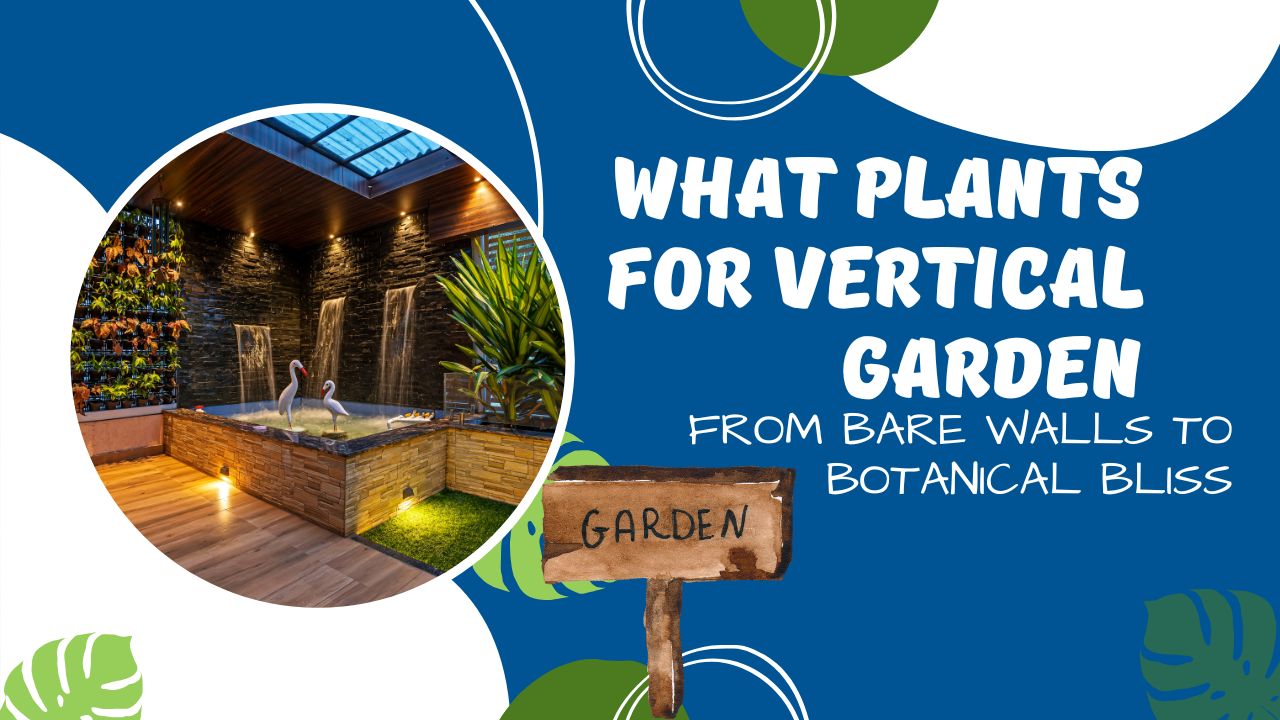
What Plants For Vertical Garden: From Bare Walls to Botanical Bliss
Vertical gardens are becoming increasingly popular in Australian homes, offering a unique way to bring greenery into urban spaces. By utilising walls and other vertical surfaces, homeowners can create lush, thriving environments that not only beautify their living areas but also contribute to a healthier lifestyle.

Choosing the right plants is crucial for a successful vertical garden. The best plants for a vertical garden are those that thrive in the specific conditions provided by the garden's design and location.
Key Takeaways
- Vertical gardens are a great way to add greenery to urban spaces.
- Selecting the right plants is crucial for a thriving vertical garden.
- The best plants are those that fit the garden's specific conditions.
- Vertical gardens can enhance the aesthetic and health benefits of a home.
- Proper plant selection ensures a low-maintenance vertical garden.
Understanding Vertical Gardens
The concept of vertical gardening has gained significant traction in Australia, offering a unique way to maximise limited space. Vertical gardens, also known as living walls or green walls, are structures that allow plants to grow upwards, utilising a trellis system or other support mechanisms.
Benefits of Vertical Gardening in Limited Australian Spaces
Vertical gardening offers numerous benefits, particularly in urban Australian environments where space is limited. These gardens not only enhance the aesthetic appeal of homes and public spaces but also contribute to improved air quality and reduced urban heat island effects. Moreover, they provide an opportunity for residents to grow their own herbs and vegetables, promoting sustainable living.

Common Vertical Garden Systems for Homes
There are several types of vertical garden systems suitable for Australian homes. These include trellis systems, pocket planters, and modular wall systems. Each system has its unique advantages and can be chosen based on the specific needs and preferences of the homeowner, including the type of plants to be grown and the available space.
Environmental Factors to Consider in Australia
When establishing a vertical garden in Australia, it's crucial to consider the local climate and environmental conditions. Factors such as sunlight exposure, wind direction, and rainfall patterns can significantly impact the health and sustainability of the garden. Selecting plants that are adapted to the local conditions is key to creating a thriving vertical garden.
What Plants for Vertical Garden: Selection Criteria
To create a lush and vibrant vertical garden, it's essential to select plants that meet specific criteria. The right plants will not only thrive in a vertical setup but also enhance the aesthetic appeal of your space.
Root System and Growth Requirements
When choosing plants for your vertical garden, it's crucial to consider their root system and growth requirements. Plants with shallow root systems are ideal as they require less soil depth. Additionally, selecting plants that grow at a moderate pace can help maintain the garden's appearance without needing constant pruning.
Weight Considerations and Structural Support
The weight of the plants, soil, and any additional features like irrigation systems must be considered to ensure the structural integrity of your vertical garden. Lightweight plants and materials can help minimise the overall weight. It's also essential to assess the structural support required for the plants as they grow.

Climate Adaptability for Australian Conditions
Australia's diverse climate means that plants chosen for a vertical garden must be adaptable to the local conditions. For indoor vertical gardens, plants that thrive in low light conditions, such as Pothos and Philodendrons, are excellent choices. For outdoor gardens, drought-resistant natives like Grevilleas are ideal.
Water and Maintenance Needs
The water and maintenance needs of plants are critical factors in a vertical garden. Plants with low water requirements are beneficial, especially in areas prone to drought. Regular maintenance, such as pruning and fertilising, should also be considered when selecting plants.
Some key considerations include:
- Choosing plants that fit the local climate and light conditions
- Assessing the mature size of plants to ensure they won't outgrow their space
- Selecting plants with similar watering needs simplifies maintenance
Best Indoor Vertical Garden Plants for Australian Homes
The right plants can make all the difference in creating a beautiful and thriving indoor vertical garden in Australian homes. When selecting plants, it's essential to consider factors like lighting, maintenance needs, and adaptability to indoor conditions.
Low Light Champions: Pothos, Philodendrons and Ferns
For areas with limited natural light, plants like Pothos, Philodendrons, and various Fern species are ideal. They not only tolerate low light but also add a lush, green texture to your indoor space. Pothos is particularly noted for its ease of care and trailing ability, making it perfect for vertical gardens.
Air-Purifying Options: Spider Plants and Peace Lilies
Indoor air quality can be significantly improved with plants known for their air-purifying properties. Spider Plants and Peace Lilies are excellent choices, capable of removing toxins from the air while being relatively low-maintenance.
Trailing Beauties: String of Pearls and Devil's Ivy
For a more decorative touch, trailing plants like String of Pearls and Devil's Ivy (Pothos) can cascade down from your vertical garden, creating a stunning visual effect. These plants are not only beautiful but also easy to care for.
Edible Indoor Choices: Herbs and Microgreens
Incorporating edible plants into your indoor vertical garden can be both practical and rewarding. Herbs like basil, mint, and cilantro, along with Microgreens, can be grown indoors, providing fresh ingredients for your cooking.
By choosing the right plants for your indoor vertical garden, you can enjoy a lush, thriving green space that enhances your home's aesthetic and contributes to a healthier indoor environment.
Top Outdoor Vertical Garden Plants for Australian Climate
For Australians looking to create an outdoor vertical garden, the variety of plants suitable for the local climate is vast and exciting. The key to a successful outdoor vertical garden lies in selecting plants that are well-suited to the Australian climate, which can range from tropical in the north to temperate in the south.
Drought-Resistant Natives: Grevilleas and Westringia
Native Australian plants are an excellent choice for outdoor vertical gardens due to their natural adaptability to the local climate. Grevilleas and Westringia are two drought-resistant natives that thrive in well-drained conditions and can tolerate full sun, making them ideal for outdoor vertical gardens.
Flowering Stunners: Bougainvillea and Native Violets
For a splash of colour, consider incorporating flowering plants like Bougainvillea and Native Violets into your outdoor vertical garden. These plants not only add vibrant hues but also attract pollinators, enhancing the biodiversity of your garden.
| Plant Type | Climate Tolerance | Maintenance Needs |
|---|---|---|
| Grevilleas | Drought-tolerant | Low |
| Westringia | Drought-tolerant | Low |
| Bougainvillea | Full sun | Moderate |
| Native Violets | Partial shade | Low |
Edible Vertical Options: Strawberries and Lettuce
Outdoor vertical gardens can also be productive. Consider growing strawberries and lettuce, which thrive in vertical conditions and provide a fresh harvest. These edible options are perfect for those looking to integrate food production into their garden design.
Shade-Tolerant Varieties: Bromeliads and Native Ferns
For areas with less sunlight, Bromeliads and Native Ferns are excellent choices. These shade-tolerant plants add lush foliage to your outdoor vertical garden and can thrive in conditions with limited direct sunlight.
By selecting the right plants for your outdoor vertical garden, you can create a beautiful, thriving green space that enhances your home and contributes to a healthier environment.
Creating Your Perfect Vertical Garden
Choosing the right plants is crucial for a thriving vertical garden. By considering factors such as root system, weight, climate adaptability, and maintenance needs, you can create a stunning and sustainable green space in your Australian home.
For indoor vertical gardens, consider low-maintenance plants like Pothos and Philodendrons, or air-purifying options like Spider Plants and Peace Lilies. Outdoor vertical gardens can feature drought-resistant natives like Grevilleas and Westringia, or flowering stunners like Bougainvillea and Native Violets.
Experiment with different types of plants for vertical gardens and designs to find what works best for you. With the right plants and a little creativity, you can enjoy the many benefits of vertical gardening, from improved air quality to enhanced aesthetic appeal.
By selecting the best vertical garden plants for your climate and space, you can create a beautiful and thriving green oasis that brings joy and serenity to your daily life.
FAQ
What are the best plants for a vertical garden in Australia?
The best plants for a vertical garden in Australia depend on whether it's indoors or outdoors. For indoor vertical gardens, consider low-light plants like Pothos, Philodendrons, and Ferns. For outdoor gardens, drought-resistant natives like Grevilleas and Westringia are excellent choices.
How do I choose the right plants for my vertical garden?
When choosing plants, consider factors like root system, growth requirements, weight, climate adaptability, and maintenance needs. For Australian conditions, it's also crucial to think about the plant's ability to withstand the local climate and potential pests.
Can I use edible plants in my vertical garden?
Yes, edible plants like herbs, microgreens, strawberries, and lettuce are perfect for vertical gardens. They're not only delicious but also add a touch of greenery to your space.
What are some easy-care plants for a vertical garden?
Plants like Spider Plants, Peace Lilies, and Devil's Ivy are known for their low-maintenance requirements, making them ideal for busy homeowners. They're also great air purifiers, adding to their benefits.
How do I ensure my vertical garden plants thrive in low light?
For low-light conditions, choose plants that are adapted to such environments, like Pothos and Philodendrons. Ensure you're not overwatering, as low-light plants tend to dry out more slowly. Also, consider using grow lights to supplement the natural light.
Are there any plants that can help purify the air in my home?
Yes, plants like Spider Plants, Peace Lilies, and Snake Plants are renowned for their air-purifying properties. Incorporating these into your vertical garden can significantly improve indoor air quality.
You might also be interested in these
- Vertical Garden for Herbs: Maximize Small Spaces with These Growing Tips
- How to Build the Perfect Vertical Garden for Strawberries: From Balcony to Backyard
- Vertical Garden for Vegetables: Maximize Your Harvest in Minimal Space
- Vertical Garden For Balcony: Turn Your Small Space into a Green Oasis
- Vertical Garden For Tomatoes: The Ultimate Guide to Vertical Tomato Gardens

